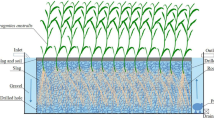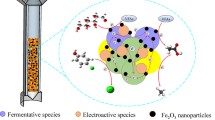Abstract
The increasing use of Fe3O4 nanoparticles (NPs) had posed an emerging challenge to wastewater treatment processes, and their potential impact on anaerobic ammonium oxidation (anammox) process of unplanted subsurface-flow constructed wetlands (USFCWs) was investigated firstly under the long-term exposure of different Fe3O4 NP concentrations. It was found that Fe3O4 NP exposure could improve total nitrogen (TN) removal. The abundance of Candidatus Anammoxoglobus increased significantly at 10 mg/L Fe3O4 NPs, while decreased under 1 mg/L Fe3O4 NP exposure. Desulfosporosinus and Exiguobacterium increased to some extent at 1 mg/L Fe3O4 NPs, suggesting that Fe-anammox played an important role in TN removal. The ROS production increased with the increase of Fe3O4 NP concentration, and the integrity of cell membrane was good under Fe3O4 NP exposure. The functional genes that related to inorganic ion transport and metabolism and lipid transport and metabolism were upregulated, and cell motility decreased after long-term exposure of 1 mg/L Fe3O4 NPs.

ᅟ





Similar content being viewed by others
References
APHA (1998) Standard methods for the examination of water and wastewater. American Public Health Association, Washington DC
Applerot G, Lellouche J, Lipovsky A, Nitzan Y, Lubart R, Gedanken A, Banin E (2012) Understanding the antibacterial mechanism of CuO nanoparticles: revealing the route of induced oxidative stress. Small 8:3326–3337
Chen H, Yu JJ, Jia XY, Jin RC (2014) Enhancement of anammox performance by Cu (II), Ni (II) and Fe (III) supplementation. Chemosphere 117:610–616
Chu Z, Wang K, Li X, Zhu M, Yang L, Zhang J (2015) Microbial characterization of aggregates within a one-stage nitritation–anammox system using high-throughput amplicon sequencing. Chem Eng J 262:41–48
Chung H, Kim MJ, Ko K, Kim JH, Kwon H, Hong I, Park N, Lee SW, Kim W (2015) Effects of graphene oxides on soil enzyme activity and microbial biomass. Sci Total Environ 514:307–313
de Almeida NM, Wessels HJCT, de Graaf RM, Ferousi C, Jetten M, Keltjens J, Kartal B (2016) Membrane-bound electron transport systems of an anammox bacterium: a complexome analysis. Biochim Biophys Acta Biomembr 1857(10):1694–1704
Ding LJ, An XL, Li S, Zhang G, Zhu Y (2014) Nitrogen loss through anaerobic ammonium oxidation coupled to iron reduction from paddy soils in a chronosequence. Environ Sci Technol 48(18):10641–10647
Ding B, Li Z, Qin Y (2017) Nitrogen loss from anaerobic ammonium oxidation coupled to iron (III) reduction in a riparian zone. Environ Pollut 231:379–386
Dwivedi S, Siddiqui MA, Farshori NN, Ahamed M, Musarrat J, Al-Khedhairy A (2014) Synthesis, characterization and toxicological evaluation of iron oxide nanoparticles in human lung alveolar epithelial cells. Colloids Surf B Biointerfaces 122:209–215
Gao C, Wang A, Wu WM, Yin Y, Zhao YG (2014) Enrichment of anodic biofilm inoculated with anaerobic or aerobic sludge in single chambered air-cathode microbial fuel cells. Bioresour Technol 167:124–132
Hai R, Wang Y, Wang X, Du Z, Li Y (2014) Impacts of multiwalled carbon nanotubes on nutrient removal from wastewater and bacterial community structure in activated sludge. PLoS One 9(9):e107345
Hira D, Toh H, Migita CT, Okubo H, Nishiyama T, Hattori M, Furukawa K, Fujii T (2012) Anammox organism KSU-1 expresses a NirK-type copper-containing nitrite reductase instead of a NirS-type with cytochrome cd 1. FEBS Lett 586(11):1658–1663
Hou J, Miao L, Wang C, Wang P, Ao Y, Qian J (2014) Inhibitory effects of ZnO nanoparticles on aerobic wastewater biofilms from oxygen concentration profiles determined by microelectrodes. J Hazard Mater 276:164–170
Hou J, Miao L, Wang C, Wang P, Ao Y, Lv B (2015) Effect of CuO nanoparticles on the production and composition of extracellular polymeric substances and physicochemical stability of activated sludge flocs. Bioresour Technol 176:65–70
Huang X, Gao D, Peng S, Tao Y (2014) Effects of ferrous and manganese ions on anammox process in sequencing batch biofilm reactors. J Environ Sci 26(5):1034–1039
Kaegi R, Voegelin A, Sinnet B, Zuleeg S, Hagendorfer H, Burkhardt M, Siegrist H (2011) Behavior of metallic silver nanoparticles in a pilot wastewater treatment plant. Environ Sci Technol 45(9):3902–3908
Li H, Chi Z, Li J (2014) Covalent bonding synthesis of magnetic graphene oxide nanocomposites for Cr (III) removal. Desalin Water Treat 52(10–12):1937–1946
Li B, Pan X, Zhang D, Lee D, Al-Misned F, Golam Mortuza M (2015) Anaerobic nitrate reduction with oxidation of Fe (II) by Citrobacter freundii strain PXL1–a potential candidate for simultaneous removal of As and nitrate from groundwater. Ecol Eng 77:196–201
Liu S, Yang F, Meng F, Chen L, Gong Z (2008) Enhanced anammox consortium activity for nitrogen removal: impacts of static magnetic field. J Biotechnol 138(3–4):96–102
Liu TY, Hu SH, Liu DM, Chen SY, Chen IW (2009) Biomedical nanoparticle carriers with combined thermal and magnetic responses. Nano Today 4(1):52–65
Liu S, Zeng TH, Hofmann M, Burcombe E, Wei J, Jiang R, Kong J, Chen Y (2011) Antibacterial activity of graphite, graphite oxide, graphene oxide, and reduced graphene oxide: membrane and oxidative stress. ACS Nano 5(9):6971–6980
Liu L, Lee D, Wang A, Ren N, Su A, Lai JY (2016) Isolation of Fe (III)-reducing bacterium, Citrobacter sp. LAR-1, for startup of microbial fuel cell. Int J Hydrog Energy 41(7):4498–4503
Ma Y, Metch JW, Vejerano EP, Miller IJ, Leon EC, Marr LC, Vikesland PJ, Pruden A (2015) Microbial community response of nitrifying sequencing batch reactors to silver, zero-valent iron, titanium dioxide and cerium dioxide nanomaterials. Water Res 68:87–97
Ma B, Wang S, Li Z, Gao M, Li S, Guo L, She Z, Zhao Y, Zheng D, Jin C, Wang X, Gao F (2017) Magnetic Fe3O4 nanoparticles induced effects on performance and microbial community of activated sludge from a sequencing batch reactor under long-term exposure. Bioresour Technol 225:377–385
Ni SQ, Ni J, Yang N, Wang J (2013) Effect of magnetic nanoparticles on the performance of activated sludge treatment system. Bioresour Technol 143:555–561
Oshiki M, Ishii S, Yoshida K, Fujii N, Ishiguro M, Satoh H, Okabe S (2013) Nitrate-dependent ferrous iron oxidation by anaerobic ammonium oxidation (anammox) bacteria. Appl Environ Microbiol 79(13):4087–4093
Quan X, Cen Y, Lu F, Gu L, Ma J (2015) Response of aerobic granular sludge to the long-term presence to nanosilver in sequencing batch reactors: reactor performance, sludge property, microbial activity and community. Sci Total Environ 506:226–233
Reinhart DR, Berge ND, Santra S, Bolyard SC (2010) Emerging contaminants: nanomaterial fate in landfills. Waste Manag 30:2020–2021
Ren Y, Li D, Li X, Yang L, Ding A, Zhang J (2014) High-rate nitrogen removal and microbial community of an up-flow anammox reactor with ceramics as biomass carrier. Chemosphere 113:125–131
Sawayama S (2006) Possibility of anoxic ferric ammonium oxidation. J Biosci Bioeng 101(1):70–72
Sevcu A, El-Temsah YS, Joner EJ, Cernik M (2011) Oxidative stress induced in microorganisms by zerovalent iron nanoparticles. Microbes Environ 26:271–281
Shimamura M, Nishiyama T, Shigetomo H, Toyomoto T, Kawahara Y, Furukawa K, Fujii T (2007) Isolation of a multiheme protein with features of a hydrazine-oxidizing enzyme from an anaerobic ammonium-oxidizing enrichment culture. Appl Environ Microbiol 73(4):1065–1072
Song YX, Chai LY, Tang CJ, Xiao R, Li BR, Wu D, Min XB (2018) Influence of ZnO nanoparticles on anammox granules: the inhibition kinetics and mechanism analysis by batch assays. Biochem Eng J 133:122–129
Sorokina AY, Chernousova EY, Dubinina GA (2012) Ferrovibrio denitrificans gen. nov., sp. nov., a novel neutrophilic facultative anaerobic Fe (II)-oxidizing bacterium. FEMS Microbiol Lett 335(1):19–25
Srinivas A, Rao PJ, Selvam G, Goparaju A, Murthy B, Reddy N (2012) Oxidative stress and inflammatory responses of rat following acute inhalation exposure to iron oxide nanoparticles. Hum Exp Toxicol 31(11):1113–1131
Straub KL, Benz M, Schink B, Widdel F (1996) Anaerobic, nitrate-dependent microbial oxidation of ferrous iron. Appl Environ Microbiol 62(4):1458–1460
Tang CJ, Duan CS, Yu C, Song YX, Chai LY, Xiao R, Wei Z, Min XB (2017) Removal of nitrogen from wastewaters by anaerobic ammonium oxidation (ANAMMOX) using granules in upflow reactors. Environ Chem Lett 15(2):311–328
Van de Graaf AA, de Bruijn P, Robertson LA, Jetten MS, Kuenen JG (1996) Autotrophic growth of anaerobic ammonium-oxidizing microorganisms in a fluidized bed reactor. Microbiology 142(8):2187–2196
Wang Z, Zhang L, Zhao J, Xing B (2016) Environmental processes and toxicity of metallic nanoparticles in aquatic systems as affected by natural organic matter. Environ. Sci Nano 3(2):240–255
Xu JJ, Zhang ZZ, Ji ZQ, Zhu YH, Qi SY, Tang CJ, Jin RC (2018) Short-term effects of nanoscale zero-valent iron (nZVI) and hydraulic shock during high-rate anammox wastewater treatment. J Environ Manag 215:248–257
Yao C, Lei HY, Yu Q, Li S, Li H, Chen K, Zhang X (2013) Application of magnetic enhanced bio-effect on nitrification: a comparative study of magnetic and non-magnetic carriers. Water Sci Technol 67(6):1280–1287
Zhang L, Yang J, Ma Y, Li Z, Fuji T, Zhang W, Takashi N, Furukawa K (2010) Treatment capability of an up-flow anammox column reactor using polyethylene sponge strips as biomass carrier. J Biosci Bioeng 110(1):72–78
Zhang ZZ, Xu JJ, Shi ZJ, Bai YH, Cheng YF, Hu HY, Jin RC (2017a) Unraveling the impact of nanoscale zero-valent iron on the nitrogen removal performance and microbial community of anammox sludge. Bioresour Technol 243:883–892
Zhang ZZ, Xu JJ, Shi ZJ, Cheng YF, Ji ZQ, Deng R, Jin RC (2017b) Combined impacts of nanoparticles on anammox granules and the roles of EDTA and S2− in attenuation. J Hazard Mater 334:49–58
Zhang ZZ, Cheng YF, Bai YH, Xu JJ, Shi ZJ, Zhang QQ, Jin RC (2018a) Enhanced effects of maghemite nanoparticles on the flocculent sludge wasted from a high-rate anammox reactor: performance, microbial community and sludge characteristics. Bioresour Technol 250:265–272
Zhang X, Zhou Y, Xu T, Zheng K, Zhang R, Peng Z, Zhang H (2018b) Toxic effects of CuO, ZnO and TiO2 nanoparticles in environmental concentration on the nitrogen removal, microbial activity and community of anammox process. Chem Eng J 332:42–48
Zhou GW, Yang XR, Li H, Marshall C, Zheng B, Yan Y, Su J, Zhu Y (2016) Electron shuttles enhance anaerobic ammonium oxidation coupled to iron (III) reduction. Environ Sci Technol 50(17):9298–9307
Funding
This work was financially supported by the National Key R&D Program of China (no. 2017YFC0505901), the National Natural Science Foundation of China (no. 41401548; no. 41772244), the Open Project of State Key Laboratory of Urban Water Resource and Environment, Harbin Institute of Technology (no. HC201622), and the China Scholarship Council (no. 201804910339 and 201806175055).
Author information
Authors and Affiliations
Corresponding author
Additional information
Responsible editor: Bingcai Pan
Highlights
• Long-term exposure of Fe3O4 NPs could increase the USFCWs performance.
• Fe-anammox played an important role in TN removal under 1 mg/L Fe3O4 NP exposure
• Desulfosporosinus and Exiguobacterium increased to some extent at 1 mg/L Fe3O4 NPs
• HDH activity of USFCWs decreased to 23% at 1 mg/L Fe3O4 NPs
• Self-adaptive ability of microbial community was explained by PICRUSt.
Rights and permissions
About this article
Cite this article
Li, H., Chi, Z. & Yan, B. Insight into the impact of Fe3O4 nanoparticles on anammox process of subsurface-flow constructed wetlands under long-term exposure. Environ Sci Pollut Res 25, 29584–29592 (2018). https://doi.org/10.1007/s11356-018-2975-1
Received:
Accepted:
Published:
Issue Date:
DOI: https://doi.org/10.1007/s11356-018-2975-1




